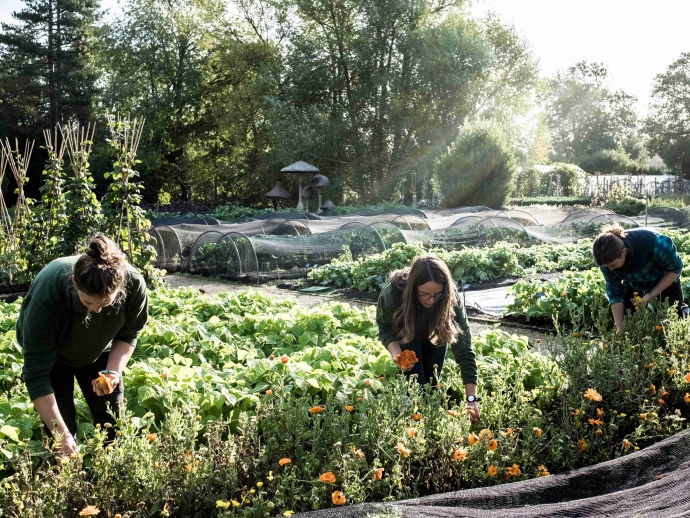Edible Landscaping: Combining Beauty with Functionality in Your Sustainable Garden

Creating an edible landscape is a fantastic way to combine beauty with functionality in your garden. Not only will you enjoy the aesthetic appeal of lush plants and vibrant colors, but you'll also have access to fresh, homegrown produce right in your backyard. In this guide, we'll explore Texas-friendly food plants, design layouts, and water management strategies to help you build a thriving and sustainable edible garden.
Texas-Friendly Food Plants
Texas offers a diverse climate that supports a wide range of edible plants. Selecting the right varieties for your region ensures a successful and productive garden. Below are some popular choices:
Shrubs and Bushes
Incorporating edible shrubs and bushes into your landscape enhances both beauty and functionality:
-
Agarita – A hardy shrub with tart red berries that can be used in jellies and syrups.
-
Blackberries – Easy to grow, these provide sweet fruit and act as a natural barrier when planted densely.
Vegetables and Herbs
Vegetables and herbs bring color, fragrance, and culinary benefits to your garden:
-
Tomatoes, Peppers, and Eggplants – These warm-season vegetables thrive in Texas’s climate.
-
Rosemary and Oregano – Hardy perennials that require minimal water and add flavor to dishes.
-
Basil, Mint, and Cilantro – Useful in cooking, these herbs grow well in container gardens or ground plots.
Wild Edibles
Foraging for native plants offers unique flavors while supporting local ecosystems:
-
Prickly Pear Cactus – Provides edible pads (nopales) and sweet fruit (tunas).
-
Turk’s Cap – Produces small edible fruits that attract pollinators like hummingbirds.
Design Layouts
A well-designed edible landscape should balance aesthetics with functionality. Here are some principles to consider:
Layered Planting
Mimic natural ecosystems by planting in layers:
-
Canopy Layer: Tall fruit and nut trees like pecans and persimmons.
-
Understory Layer: Shrubs such as blackberries and agarita.
-
Ground Cover: Herbs and leafy greens to retain soil moisture and prevent erosion.
Companion Planting
Pairing plants that benefit one another boosts productivity and pest resistance:
-
Marigolds with Tomatoes – Deters nematodes and pests.
-
Basil with Peppers – Enhances flavor and repels insects.
-
Beans with Corn – Beans fix nitrogen in the soil, benefiting corn growth.
Pathways and Access
Create a practical layout with clear pathways:
-
Stone or Mulch Walkways – Prevent soil compaction and provide easy access for maintenance and harvesting.
-
Raised Beds – Organize planting areas efficiently and improve drainage.
Water Management
Texas's climate can be challenging for gardening, making efficient water management essential. Here are sustainable strategies:
Rainwater Harvesting
Collect and store rainwater to reduce dependence on municipal sources:
-
Rain Barrels – Capture runoff from roofs for use in irrigation.
-
Storage Tanks – Larger systems can provide water during dry periods.
Drip Irrigation
Efficient watering methods help conserve water:
-
Drip Lines and Soaker Hoses – Deliver water directly to plant roots, minimizing evaporation and runoff.
-
Timers and Sensors – Automate irrigation schedules based on soil moisture levels.
Mulching
Applying mulch improves soil health and conserves moisture:
-
Organic Mulch (Wood Chips, Straw, or Leaves) – Helps regulate soil temperature and retain water.
-
Living Mulches (Clover, Thyme, or Creeping Herbs) – Enhance soil fertility while reducing weeds.
Additional Tips for a Thriving Edible Landscape
-
Incorporate Pollinator-Friendly Plants – Flowers like lavender, bee balm, and sunflowers attract bees and butterflies, improving fruit and vegetable yields.
-
Rotate Crops Annually – Prevent soil depletion and reduce pest infestations by changing planting locations each season.
-
Utilize Vertical Gardening – Grow vining plants like grapes, cucumbers, or beans on trellises to maximize space.
-
Compost Kitchen Waste – Enrich your soil with homemade compost to boost plant growth naturally.
-
Choose Native and Drought-Tolerant Plants – Adapted species require less maintenance and withstand Texas’s climate conditions better.
Conclusion
Creating an edible landscape in Texas is a rewarding way to enhance your outdoor space while providing fresh produce for your family. By selecting Texas-friendly plants, designing a thoughtful layout, and implementing effective water management strategies, you can enjoy both the beauty and bounty of your garden.
Whether you're a seasoned gardener or just starting out, incorporating edible landscaping into your yard will bring you closer to nature and nourish your community. With careful planning and sustainable practices, your garden can be a thriving, productive, and visually stunning space year-round.

